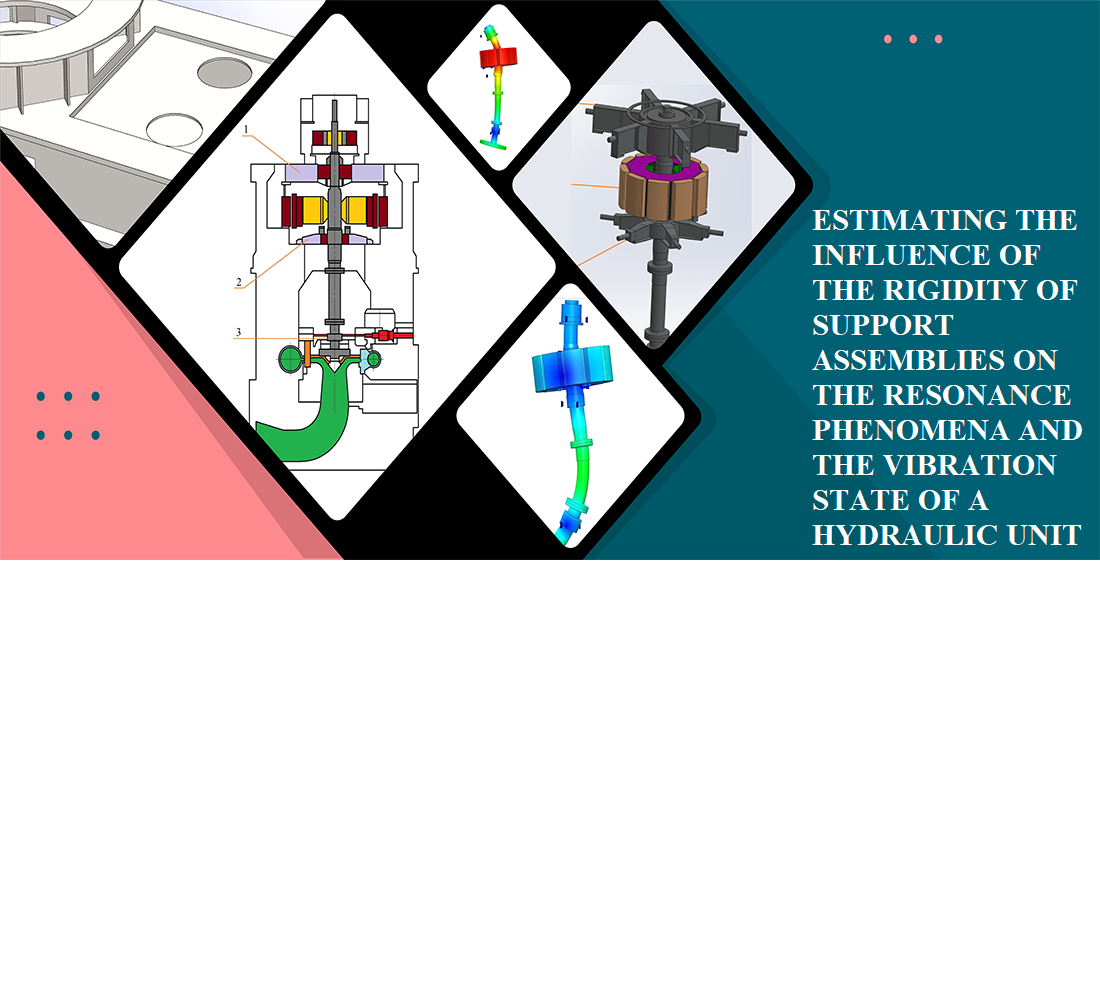Estimating the influence of the rigidity of support assemblies on the resonance phenomena and the vibration state of a hydraulic unit
DOI:
https://doi.org/10.15587/1729-4061.2024.316778Keywords:
umbrella-type hydrogenerator, rotor, vibration, stiffness, critical rotation frequency, three-dimensional computation, flexibility of hydrogenerator supports, hydrogenerator crossheadAbstract
Many factors affect the vibration of the hydraulic unit, including the natural oscillation frequencies of the structural elements, which in some cases may contribute to an increase in vibration because of the occurrence of resonance phenomena.
In this work, the case of design optimization of the support assemblies of the shaft pipeline of the hydrogenerator-motor was considered, installed at HSPP during its reconstruction in order to improve vibration parameters. The effect of increasing the stiffness of the upper crosspiece and reducing the weight of the rotating parts on the value of the first and second critical rotation frequencies was analyzed. Based on the results of computations, operability of the proposed new reinforced structure of the upper crosspiece of the hydrogenerator-motor with increased rigidity was confirmed. Using this design could increase the first critical rotation frequency from 9 Hz (540 rpm) to 17.6 Hz (1056 rpm). This would lead to the avoidance of resonance phenomena caused by the proximity of the first critical rotation frequency of the rotor to the rated rotation frequency (600 rpm).
The computations were performed in a three-dimensional setting in two stages for each of the considered design cases. At the first stage, the supporting elements rigidity of the shaft line of the hydrogenerator-motor were studied by determining the structural element elastic deformations when it was loaded by a transverse force. At the second stage, these determined stiffnesses of the support elements were used as input data for calculating the critical rotation frequencies of the hydraulic unit rotor
References
- Lei, Y., Lin, J., He, Z., Zuo, M. J. (2013). A review on empirical mode decomposition in fault diagnosis of rotating machinery. Mechanical Systems and Signal Processing, 35 (1-2), 108–126. https://doi.org/10.1016/j.ymssp.2012.09.015
- Melfi, M. J., Umans, S. D. (2023). DC machines. Encyclopedia of Electrical and Electronic Power Engineering, 264–279. https://doi.org/10.1016/b978-0-12-821204-2.00005-2
- Werner, U. (2024). Active vibration control for rotating machines with current-controlled electrodynamic actuators and velocity feedback of the machine feet based on a generalized mathematical formulation. Control Theory and Technology. https://doi.org/10.1007/s11768-024-00230-w
- Tan, X., Deng, P., Chen, W., Zucca, S., Berruti, T. M., Wang, T., He, H. (2024). Parametric instability analysis of rotors under anisotropic boundary conditions. International Journal of Mechanical Sciences, 284, 109739. https://doi.org/10.1016/j.ijmecsci.2024.109739
- Gerling, D. (2014). DC-Machines. Electrical Machines, 37–88. https://doi.org/10.1007/978-3-642-17584-8_2
- Mollet, Y., Barbierato, G., Gyselinck, J. (2016). Finite-element and magnetic-equivalent-circuit modelling of brushed wound-field DC machines with cross-saturation. 2016 XXII International Conference on Electrical Machines (ICEM), 350–356. https://doi.org/10.1109/icelmach.2016.7732550
- Zhang, H., Wang, L., Wang, A. (2023). Vibration response analysis of gas generator rotor system with squeeze film damper based on dynamic similarity. Results in Engineering, 20, 101618. https://doi.org/10.1016/j.rineng.2023.101618
- Sukma Nugraha, A., Djunaedi, I., Alam, H. S. (2015). Evaluation of Critical Speed of the Rotor Generator System Based on ANSYS. Applied Mechanics and Materials, 799-800, 625–628. https://doi.org/10.4028/www.scientific.net/amm.799-800.625
- Subbiah, R., Littleton, J. E. (2018). Rotor and Structural Dynamics of Turbomachinery. In Applied Condition Monitoring. Springer International Publishing. https://doi.org/10.1007/978-3-319-73296-1 1
- Lang, X., Nilsson, H., Mao, W. (2024). Analysis of hydropower plant guide bearing vibrations by machine learning based identification of steady operations. Renewable Energy, 236, 121463. https://doi.org/10.1016/j.renene.2024.121463
- Ohashi, H. (2016). Vibration and Oscillation of Hydraulic Machinery. Routledge. https://doi.org/10.4324/9781315235097
- Zhang, W., He, Y.-L., Xu, M.-X., Zheng, W.-J., Sun, K., Wang, H.-P., Gerada, D. (2022). A comprehensive study on stator vibrations in synchronous generators considering both single and combined SAGE cases. International Journal of Electrical Power & Energy Systems, 143, 108490. https://doi.org/10.1016/j.ijepes.2022.108490
- Pérez, N., Rodríguez, C. (2021). Vertical rotor model with hydrodynamic journal bearings. Engineering Failure Analysis, 119, 104964. https://doi.org/10.1016/j.engfailanal.2020.104964

Downloads
Published
How to Cite
Issue
Section
License
Copyright (c) 2024 Oleksii Tretiak, Anton Kovryga, Stanislav Kravchenko, Denys Shpitalnyi, Anton Zhukov, Serhii Serhiienko, Mariia Arefieva, Nataliia Penkovska, Andrii Madonych

This work is licensed under a Creative Commons Attribution 4.0 International License.
The consolidation and conditions for the transfer of copyright (identification of authorship) is carried out in the License Agreement. In particular, the authors reserve the right to the authorship of their manuscript and transfer the first publication of this work to the journal under the terms of the Creative Commons CC BY license. At the same time, they have the right to conclude on their own additional agreements concerning the non-exclusive distribution of the work in the form in which it was published by this journal, but provided that the link to the first publication of the article in this journal is preserved.
A license agreement is a document in which the author warrants that he/she owns all copyright for the work (manuscript, article, etc.).
The authors, signing the License Agreement with TECHNOLOGY CENTER PC, have all rights to the further use of their work, provided that they link to our edition in which the work was published.
According to the terms of the License Agreement, the Publisher TECHNOLOGY CENTER PC does not take away your copyrights and receives permission from the authors to use and dissemination of the publication through the world's scientific resources (own electronic resources, scientometric databases, repositories, libraries, etc.).
In the absence of a signed License Agreement or in the absence of this agreement of identifiers allowing to identify the identity of the author, the editors have no right to work with the manuscript.
It is important to remember that there is another type of agreement between authors and publishers – when copyright is transferred from the authors to the publisher. In this case, the authors lose ownership of their work and may not use it in any way.









